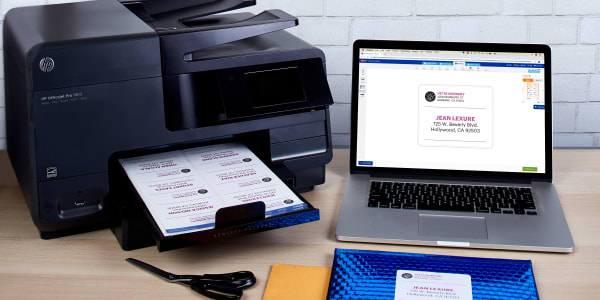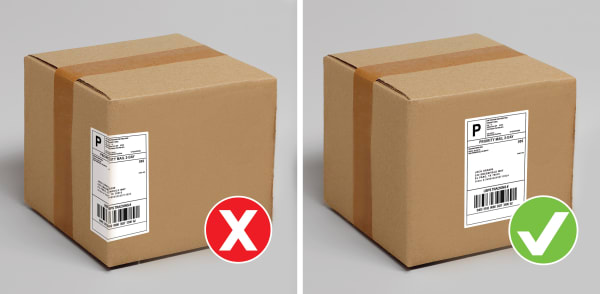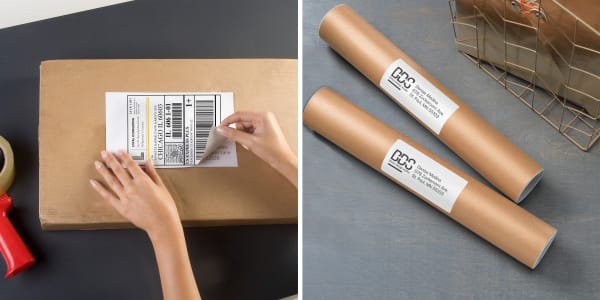Avoid mistakes so your packages arrive on time
Shipping label “fails” can easily cause your package to be delayed, or worse, lost in transit. While losing a personal package can be emotionally devastating, losing a work package can cost you time and money. Fortunately, we have a long history of making labels, and we apply that experience to solving label failures every day.
Whether you’re new to shipping and need to know how to ship a package or new to creating and printing your own shipping labels, this article is for you. First and foremost, we’ll help you spot common shipping label failures and learn how to avoid them so that your packages arrive safely and on time. We’ll also share our best tips for creating more professional-looking shipping labels.
Other articles and resources you might like:
- Where to Buy Postage Online
- How to Streamline Your Mailing Center

1) How to avoid skewed or cut off information
Start with shipping labels that are optimized for DIY printing. We designed Avery shipping labels with Sure Feed® technology to move more smoothly through average desktop and office printers. These labels feature a patented, unique “grip” strip that helps you print with fewer misalignments, paper jams, and wasted labels. If you still have issues printing, the printer settings or label size may be incorrect.
Learn More about Sure Feed Technology
Printer settings
First, open the “Properties” or “Preferences” tab in the printer dialog. Then choose the “Label”setting. If there is no label setting, then “Heavyweight,” “Cardstock,” or“Photo” will also work. For more detailed help, check out ourstep-by-step instructions for choosing the best printer settings for labels.
Wrong size label
Sizes for shipping labels can vary between carriers and services. However, you can quickly find the right size for shipping with our guide to choosing the right shipping label. Our guide includes sizes for UPS®, USPS®, Fedex®, Amazon®, eBay®, Etsy®, Stamps.com®, and more.

2) How to avoid shipping labels that don’t stay on
It’s easy to blame this particular shipping label fail entirely on adhesives, but that’s not always the whole story. We engineer Avery labels with Ultrahold® adhesive to hold better than generic labels, so that’s a great place to start. If your shipping labels still fail to stay on or the edges keep peeling up, check for these issues:
The package surface is not clean
Old boxes stored in garages or sheds, pet hair, and lint are all common culprits when it comes to shipping label fails. Solution: A quick wipe with a microfiber cloth will remove dust, pet hair, and lint. Store boxes that you intend to reuse somewhere safe from dampness and/or oil and grease.
The surface is not even
Strong adhesives don’t matter if they can’t make contact with the package surface. Solution: Place shipping labels on the most prominent flat portion of the package so that the label makes full contact. Avoid seams, box openings, and wrinkles or folds on soft packaging.
The label is not meant for shipping
Some labels are designed to be easily removed, and they’re simply not meant to stick to surfaces permanently. Solution: Double-check that you’re using shipping labels with permanent adhesive and not removable labels.
The adhesive hasn’t set
Repositionable shipping labels like these ones are removable for a short time, then the adhesive sets and becomes permanent. Solution: Make sure you let repositionable labels sit until the adhesive becomes permanent before shipping your package.
Myth: Clear tape keeps shipping labels stuck on and protects them. While that sounds good in theory, it's risky. First of all, the tape is only sticking to a very small surface area of the package compared to an adhesive label. Secondly, the glare from the tape can interfere with barcode scanning and delay your package. Not to mention, it looks messy and unprofessional. If you’re worried about your package getting wet, it’s better to just use a waterproof shipping label.
3) Why are my printed labels smudging?
There are two main reasons your printed labels are smudging. 1) Using the wrong type of printer for the labels 2) Using labels that are not water-resistant The wrong type of printer will cause smudging because laser printers set dry, powdered ink with heat, and inkjet printers spray wet ink onto the labels. If you use an inkjet printer with laser labels, the labels won’t absorb the ink, and the ink will never dry,” causing smudging. If you use a laser printer with inkjet labels, it can cause dark areas that look like smudges, or worse, melt the labels!
The best way to keep labels from smudging is to make sure you’re using the right type of labels for the printer you have, which we wrote about in greater detail here. And of course, if you intend for your labels to come into contact with water, make sure you use water-resistant or waterproof labels.
Incompatible printers
Above, we discussed why using the wrong printer causes smudged labels. But do you need a specific printer for shipping labels? The short answer is no. The type of printer you use is not as important as matching your labels to that printer type (i.e., laser labels for laser printers and inkjet labels for inkjet printers). If you don’t know what kind of printer you have, this article can help you figure out if you have a laser or inkjet printer.
Shop Laser Labels
Shop Inkjet Labels
One way to tell that you’re using the wrong printer for your shipping labels is if the ink just never seems to dry after printing. Because labels tend to smudge when used with the wrong printer, many people think a specific printer is needed—but no, you just need the right labels for the one you have. Aside from specific labels for your printer, you can also use specially engineered shipping labels like these ones that are designed to work with both laser and inkjet printers.
The weather
Winter and rainy seasons can wreak havoc on your shipping labels. For this reason, we make Avery waterproof shipping labels from a durable polyester film that can withstand rain and snow. Even if the skies are clear in your area, you never know what type of weather your package might encounter if it has a long way to travel.
Reprinting on custom-printed labels
Do not try to run professionally printed labels through your printer. This applies to any labels you have ordered to be custom printed for you. For one thing, you just can’t be sure if the material is compatible with your printer. In fact, using the wrong material in your printer causes all kinds of problems (including smeared ink). Moreover, custom-printed labels often have a special topcoat. Even if the material is compatible, the topcoat may prevent ink from fully transferring on a reprint.
4) How to avoid barcode scanning errors
Barcode scanners work by shining light on a barcode and then “reading” the barcode based on how the light is reflected. This works because the light and dark parts of the barcode reflect light differently. To sum up, the way the contrasting sections reflect light is what makes barcodes “readable” by machines (the barcode scanner).
Disrupting the contrast or shape of barcode labels can quickly lead to shipping label fails that cause delayed or even lost packages. Here are the best ways to avoid scanning fails on shipping labels:
Use ink that contrasts with your label color
Barcode scanners require high contrast to properly scan. Stick to bright white, pastel, or neon shipping labels with black ink. If you need to make your own barcodes, check out the free Avery barcode generator.
Avoid bleed-through from what’s underneath
Reusing packaging is great for the environment and a great way to ship on a budget. However, when information from leftover labels bleeds through, the light from a barcode scanner can reflect differences in those areas.
Instead of taking a chance on bleed-through, use Avery labels with TrueBlock technology. TrueBlock is a special backing that completely blocks everything underneath, including permanent marker ink, images, and old barcodes.
Shop Labels with TrueBlock technology
Avoid wrinkles and creases
Wrinkles and creases on or near the barcode area of a shipping label distort the information the scanner is trying to read. Place your shipping labels on the flattest surface of your package and avoid seams, box openings, and wrinkles or folds on soft packaging.
Do not fold, bend, or wrap labels
Never fold or bend shipping labels on the edges of boxes, and always place barcodes lengthwise on tube packaging. Bent, folded, or wrapped barcodes cause the light from scanners to reflect in several directions, often away from the scanner entirely.

5) Where to put the shipping label on the box
The reason it matters where you put the shipping label on a box is so that mail carriers can accurately scan the barcode. As mentioned above, barcodes work better the flatter the surface is, so you should always put your shipping label on the flattest and most prominent surface of a box. Avoid any seam or box opening that may cause a wrinkle, and never fold or bend shipping labels around the edges or corners of boxes.
Where do you write on a shipping box?
On a shipping box, you may prefer to handwrite the address or return address (although you will still get a shipping label with a barcode when you pay for postage). Before you write on your shipping box, consider where the postage barcode will need to be placed (i.e., the flattest, most prominent surface, away from any seams or the box opening). Then go ahead and handwrite your address and return address according to USPS guidelines, leaving plenty of space for the shipping label.
Where to put a return label on a package?
The best place to put a return label on a package is the same place as the original label: on the flattest, most prominent surface, away from any seams or the box opening. Unfortunately, that original label can cause you issues if the carrier confuses the two labels or if you put the return label over it but the information bleeds through and disrupts the barcode scanner. To avoid these pitfalls, you should always remove the original label before adding your return label. Or, use labels with TrueBlock technology, which have a special backing that covers everything underneath and prevents bleed-through.

6) Where to put a shipping label on an envelope?
Putting a shipping label on an envelope can be tricky because often the contents of the envelope are not completely flat, especially when using bubble mailers for items that are not flat. The best place to put the shipping label is on the flattest part of your envelope, on the side without the flap. This avoids bumps from extra tape or metal fasteners on the envelope.
7) Missing or wrong information on the shipping label
Missing or incorrect information on shipping labels is nearly guaranteed to cause problems and can prevent your package from being delivered. Here’s a quick checklist you should go through every time you mail a package:
Is the address of the destination correct?
You should always double-check the address before printing your label or buying postage. Fortunately, the post office has an online tool that will allow you to validate any address in the United States. In the U.S., sometimes the difference can be as small as an abbreviation, such as “East” vs. “E” in a street name. And this free online tool helps verify international addresses by comparing the address with the postal regulations of the country in which the address is located.
Does my shipping label need a barcode?
All mail carriers require a barcode on your package in order to scan the shipping information. However, the address and return address can be on a separate shipping label from the one you will get when you pay for postage. While you can use a separate label or even handwrite the address and return address if you like, you will still have to have a shipping label from the carrier with a barcode on it. For example, you can use free templates to create customized shipping labels for your company, which would include your logo, your company’s return address, and the destination address. Then, whichever carrier you use will give you a barcode label when you pay for postage online or in person.
Do you have the correct postage for the package?
If you buy postage online, making sure the delivery address, weight, and measurements of your package are correct is crucial. This is because postage is calculated by the type of package (e.g., an envelope or bag vs. a box), the dimensions, the weight, and how far the package must travel. When postage is incorrect, sometimes a carrier may just charge you an additional fee if you have a linked account. However, most often, if you haven’t paid enough postage, they simply won’t pick it up. Or, it may be returned to you if you drop the package off at a facility.
How to apply shipping labels perfectly every time
First, wipe down the area with a paper towel or cloth to remove pet hair, lint, dust, or other debris. After the surface is wiped down, peel off the shipping label backing and hold the label by its outer edges. Then place the label on your package, starting with one edge, and roll the rest of the shipping label onto the package to avoid wrinkles. Finally, firmly press down the shipping label from edge to edge to make sure it’s secure.
Let Avery solve your shipping label fails
Without a doubt, Avery shipping labels are the best place to start to avoid shipping label fails. We put decades of research and development behind every label to set you up for success. We also make purchasing easier with in-store retail packs, blank labels by the sheet, and our WePrint® custom printing services.
Nevertheless, life happens, and problems do pop up from time to time. You can find tons of answers to common questions in the Avery Help Center, drop us a comment with your question, or learn more about labeling basics on our blog.
And of course, you can always call our excellent Customer Care Team as well—they’re happy to walk you through any issue and problem-solve for you.
Author: JoJo Mrgich
JoAnn (JoJo) Mrgich is a copywriter and SEO content writer who began her copywriting career in 2011. A musical theater major at the time, JoJo began writing blog articles, product descriptions, and other online content for a dancewear brand. Since then, she has gone on to write in a variety of fields, from essential oils and natural beauty to fashion and swimwear, finally landing at Avery, which she affectionately calls her "forever home."At Avery, JoJo writes content for the Avery blog, covering everything from organization to party planning, as well as contributing to other online content for avery.com. She is also a technical and content writer for Avery Industrial, where she writes in-depth articles that span a wide variety of topics, from safety compliance to 5S lean practices.In her personal life, JoJo is a big fan of fantasy and science-fiction works such as Lord of the Rings and Star Trek (especially the original series). She also loves going to Disneyland and runs a non-profit social organization of 600 members that brings fans of "nerd culture" together for meet-ups and events in Southern California.View all posts by JoJo Mrgich
